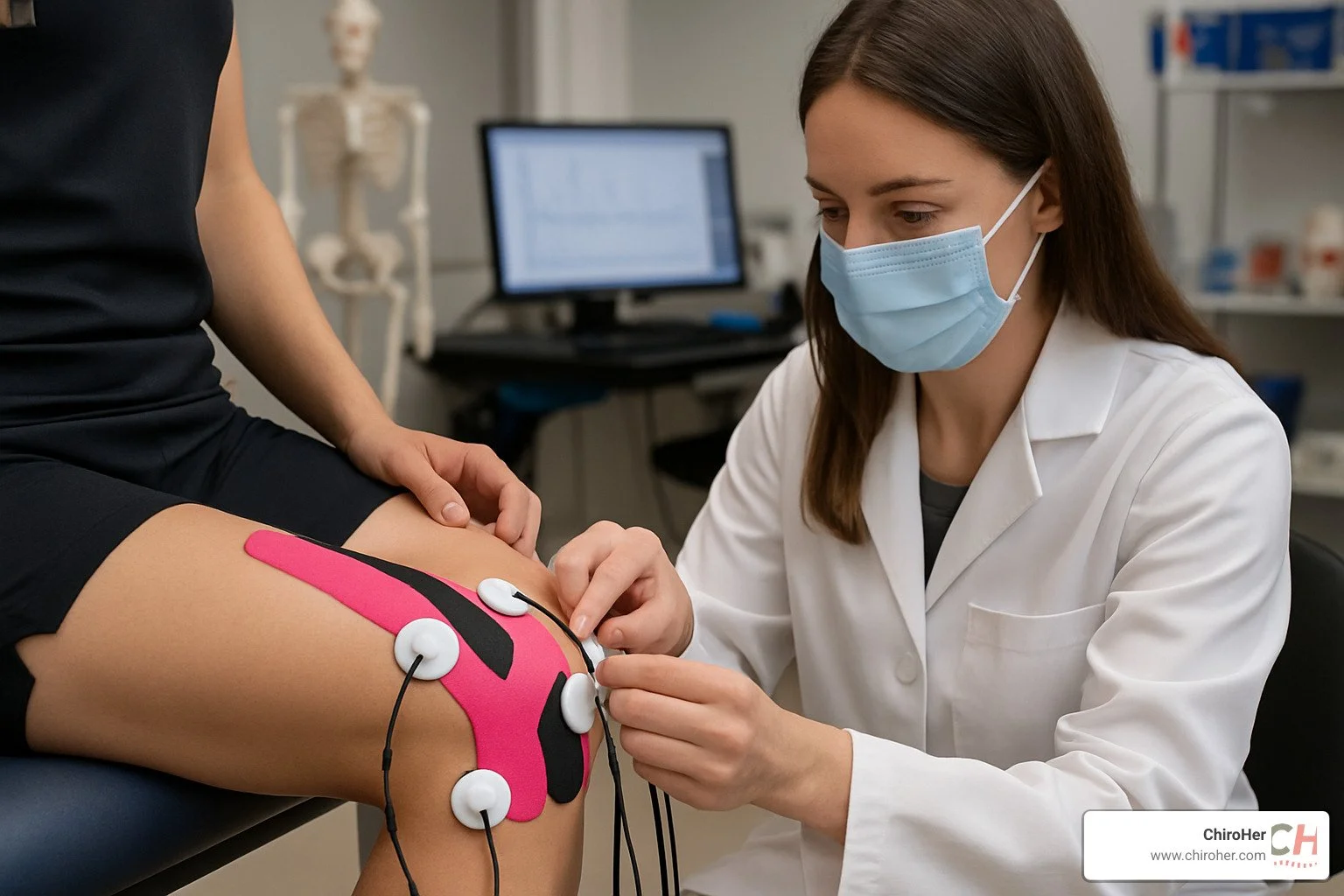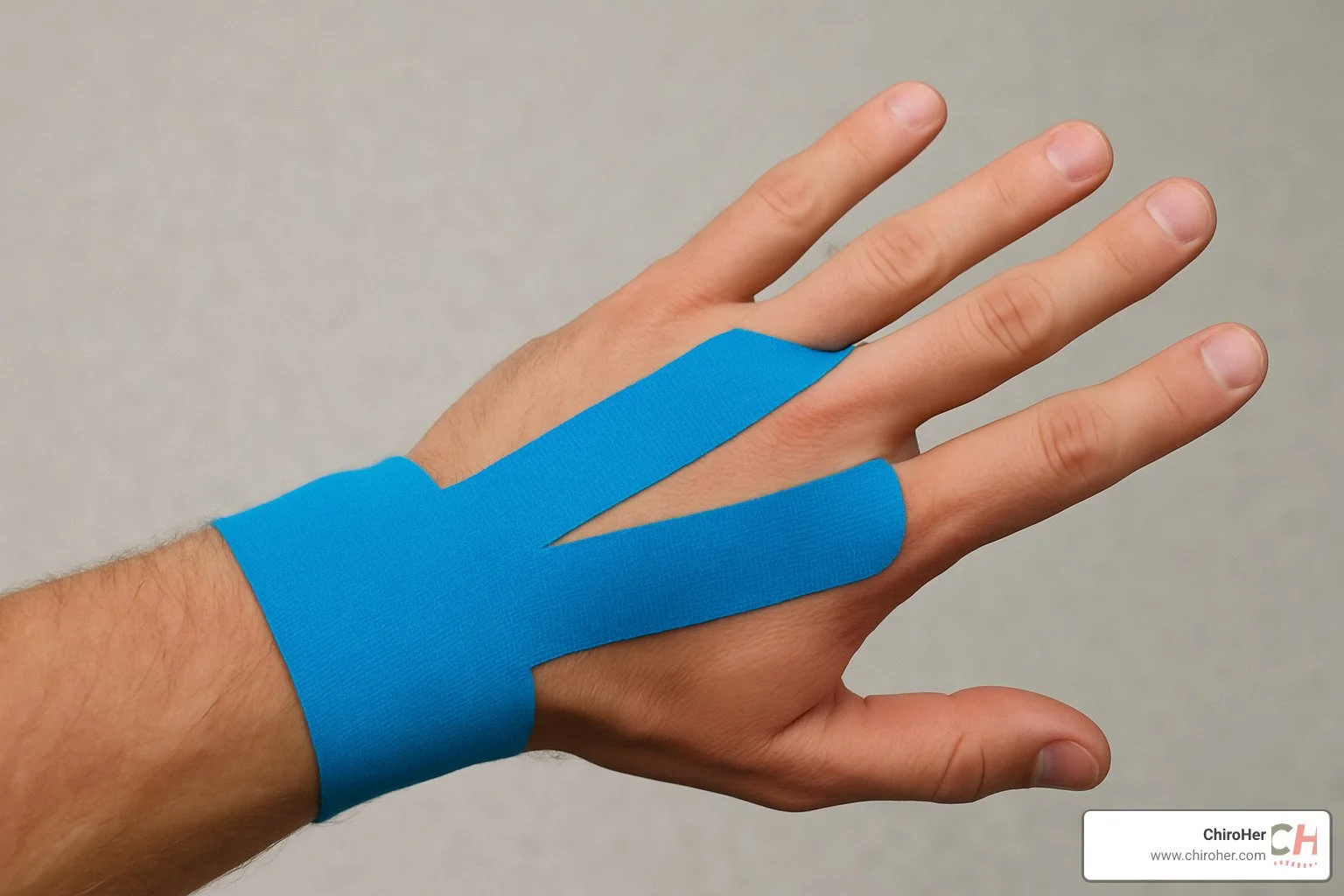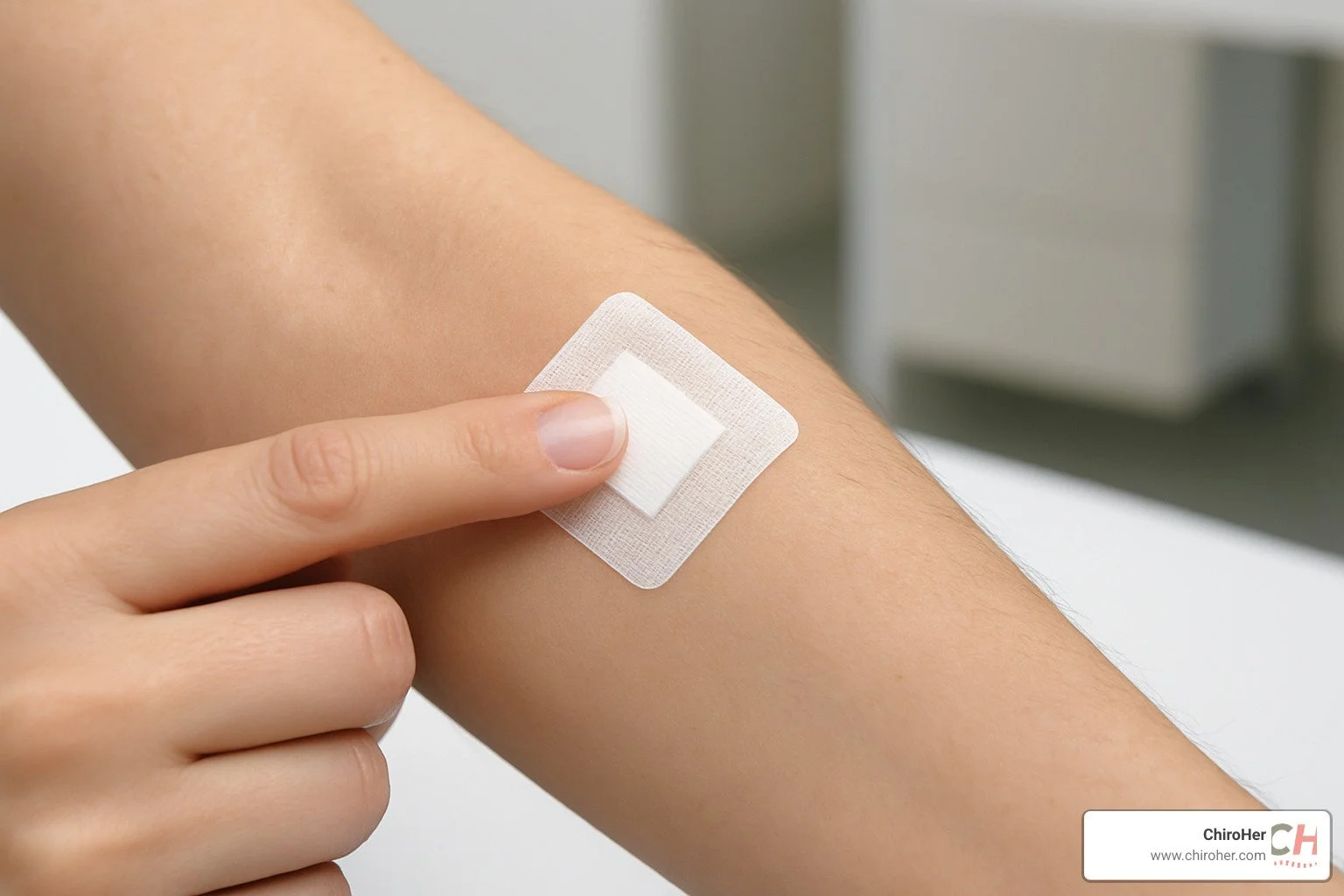How Does KT Tape Work? The Science (and Mystery) Explained
The Colorful Tape Taking Sports Medicine by Storm
How does KT tape work? KT tape (kinesiology tape) works by lifting the skin microscopically to create space beneath the tissue. This lifting action improves lymphatic drainage, reduces pressure on pain receptors, and improves circulation while providing gentle support without restricting movement.
Quick Answer - KT Tape's Three Main Mechanisms:
Skin Lifting - Creates micro-space under skin to reduce pressure and improve fluid flow
Sensory Feedback - Stimulates nerve receptors to modulate pain signals and improve body awareness
Elastic Support - Provides gentle muscle and joint support while maintaining full range of motion
You've probably seen it everywhere - colorful strips of tape adorning athletes' shoulders, knees, and backs. What started as brightly colored patterns on Olympic volleyball players has become a staple in sports medicine clinics, physical therapy offices, and even pregnancy support routines.
But despite its popularity, KT tape remains somewhat mysterious. How exactly does a thin piece of stretchy tape provide pain relief and support? The science is both fascinating and still evolving.
The tape can stretch up to 100% of its resting length, mimicking human skin elasticity. Unlike rigid athletic tape that restricts movement, KT tape allows full range of motion while theoretically providing therapeutic benefits through skin manipulation and sensory input.
Research shows mixed results - some studies demonstrate short-term pain relief and improved function, while others question whether the benefits exceed placebo effects. What's clear is that when KT tape works, it's often as part of a comprehensive treatment plan rather than a standalone solution.
As Dr. Michelle Andrews, D.C., and founder of ChiroHer, I've used KT tape extensively in my practice to support expecting mothers, athletes, and patients recovering from injuries - always questioning how does KT tape work to provide the most effective, evidence-based care.
How Does KT Tape Work on a Physiological Level
When properly applied, KT tape's elastic recoil creates "decompression" beneath the skin. Think of it like gently lifting a heavy blanket off your body - suddenly there's space to breathe and move.
Scientific research on joint-space increase demonstrates that kinesiology tape actually increases space within joints. In one study of 32 participants, tape applied over the knee measurably increased joint space, potentially reducing irritation and improving function.
The tape's 140% bilinear elasticity matches human skin's natural stretch capacity, working with your body's movement patterns rather than fighting against them. This creates three distinct physiological effects that work together to provide relief and support.
Skin Lift & Fluid Dynamics: how does kt tape work
The foundation of how does KT tape work starts with mechanical skin lifting. When the tape recoils after application, it creates tiny pockets of space under your skin, triggering beneficial effects.
Pressure relief happens immediately. Those free nerve endings that signal pain when compressed suddenly have room to breathe. Less mechanical pressure means fewer pain signals traveling to your brain.
The lymphatic drainage improvement is particularly interesting. Your lymphatic system relies on muscle movement and tissue compression to keep fluid moving. When KT tape lifts the skin, it creates space for lymphatic fluid to flow more freely.
I've seen this effect with pregnant patients who come in with swollen ankles. Within 24 hours of proper taping, the puffiness noticeably decreases. The tape essentially gives their overworked lymphatic system assistance.
Blood flow improvements follow the same principle. The decompression effect increases circulation to the taped area. Some patients notice that bruises under tape change color faster than untaped areas, suggesting improved oxygen delivery helps with healing.
Sensory Feedback: how does kt tape work on nerves
Your skin contains specialized nerve endings called mechanoreceptors that detect touch, pressure, and movement. The tape creates constant, gentle stimulation of these receptors.
According to the pain gate theory, this non-painful sensory input can "close the gate" on pain signals traveling to your brain. It's like when you rub your elbow after hitting it - the rubbing sensation competes with the pain signal.
KT tape may also help restore proprioception - your body's ability to sense position and movement. The tape's stretch and recoil constantly stimulate skin receptors, sending increased signals to your brain about what's happening in that area. Better communication often means improved muscle coordination and joint stability.
Structural Support Without Restriction
Unlike rigid athletic tape that limits movement, how does KT tape work is fundamentally different - it provides support while preserving full range of motion.
The tape's elastic recoil creates gentle, constant tension that supports muscles and joints without creating stiffness. This 100% stretch capacity allows the tape to move with your body's natural patterns.
The unidirectional stretch is particularly clever. The tape stretches lengthwise but not widthwise, allowing targeted support along specific movement directions while preserving mobility in others.
These mechanisms work together - skin lifting improves circulation, sensory feedback helps with pain and coordination, and elastic support maintains function. It's smart biomechanics working with your body's natural healing processes.
Benefits and Ideal Uses of KT Tape
Feature KT Tape Traditional Athletic Tape Stretch Up to 100%+ Minimal to none Duration 3-5 days Hours to 1 day Movement Full range of motion Restricted Purpose Pain relief, support Stability, immobilization Water Resistance Yes Limited Skin Breathability High Low
Understanding how does KT tape work becomes clear when you see its versatility. Unlike rigid tape that restricts movement, KT tape lets you move naturally while providing support.
The benefits extend beyond pain relief. KT tape excels at swelling control through lymphatic drainage effects, muscle cueing to help retrain movement patterns, and postural support without restriction. For pregnant patients, it's become a game-changer for belly support without the bulk of traditional maternity belts.
Common Injuries & Conditions
Runner's knee is where KT tape often shines brightest. Applied around the kneecap, it helps improve patellar tracking while reducing pain. The tape gives your kneecap a gentle reminder of proper positioning.
For tennis elbow, we apply tape to calm overworked wrist extensor muscles while supporting the elbow joint. Plantar fasciitis patients often describe the tape as having a supportive insole built into their foot.
Research on lymphedema is particularly encouraging. Studies on breast cancer patients show KT tape can help reduce fluid buildup through its skin-lifting effect.
At ChiroHer, we've had success with carpal tunnel syndrome using targeted techniques. Learn more in our guide on Kinesio Tape for Carpal Tunnel Syndrome.
Pregnancy support deserves special mention - the tape can lift and support a growing belly while allowing full movement, something rigid belts can't match.
When KT Tape Shines (and When It Doesn't)
KT tape excels during acute injuries with swelling, especially in the first 48-72 hours when traditional bracing might be too restrictive. It's fantastic for chronic pain conditions needing ongoing support and perfect when you need support with full mobility.
However, KT tape has limitations. Unstable fractures or severe joint instability need proper medical immobilization. Open wounds or active skin infections are obvious contraindications, and anyone with compromised circulation should avoid it.
A 2012 meta-analysis found that while KT tape provided significant short-term pain relief, only patients in exercise programs improved long-term. The tape is a supporting tool, not a standalone solution.
Integrating KT Tape Into Rehab Plans
After manual therapy sessions, we often apply KT tape to maintain benefits between visits. Combined with specific exercises, it helps retrain proper movement patterns.
We follow a progressive approach - starting with pain relief and swelling control, then transitioning to muscle re-education as patients heal. Our Therapeutic Exercises programs often incorporate KT tape to help maintain proper form during rehabilitation.
Evidence, Limitations, and Ongoing Research
When patients ask how does KT tape work, I share both promising research and honest limitations. The scientific evidence presents a fascinating but incomplete picture.
What Studies Say (And Don't Say)
Some studies show genuinely promising results. A 2018 study in the Orthopaedic Journal at Harvard Medical School found that patients with shoulder impingement experienced reduced pain and improved function when KT tape was combined with physical therapy.
A 2019 study in the Journal of Sports Rehabilitation showed athletes experienced decreased muscle soreness and improved recovery after exercise with kinesiology tape. Small but well-designed studies have measured actual increases in joint space and improved lymphatic drainage.
However, a 2020 review in the American Journal of Physical Medicine & Rehabilitation raised questions about clinical significance compared to other treatments. Many studies suffer from small sample sizes and lack long-term follow-up.
The scientific research on pain relief meta-analysis reveals inconsistent results across different conditions. This variability suggests individual factors play significant roles in effectiveness.
Research challenges make KT tape difficult to study. Application techniques vary dramatically between practitioners. The visible nature makes true placebo-controlled studies nearly impossible. Individual differences in anatomy and injury types also influence results.
Myths, Colors, and Placebo
Tape color myths need addressing. Research consistently shows pink tape works exactly the same as black, blue, or any other color. The original tape was plain beige - colors were added for aesthetics and marketing.
Performance improvement claims represent another area where marketing has outpaced evidence. Studies haven't demonstrated significant performance improvement in healthy athletes. The tape's primary benefits appear therapeutic rather than performance-boosting.
In practice, I use the "30% improvement rule" - if a patient doesn't feel at least 30% improvement immediately after proper application, the benefit is likely minimal. Real therapeutic effects should be noticeable within minutes to hours.
Evidence versus stories presents an ongoing challenge. Individual success stories are meaningful but don't constitute scientific proof. The placebo effect is real and can provide genuine relief, but it's important to distinguish between placebo benefits and measurable therapeutic effects.
Proper Application: Step-by-Step Guide
Understanding how does KT tape work is only half the battle - proper application makes the difference between therapeutic success and colorful disappointment.
Preparing Skin & Choosing Tape
Before touching the tape, your skin needs preparation. Start with squeaky-clean skin using rubbing alcohol to remove dirt, lotions, and oils. Your skin should be completely dry before application.
Hair longer than 1/8 inch will prevent proper skin contact. A quick trim with scissors usually works. Always test for allergies first - apply a small strip to your forearm for at least an hour. About 5-15% of people experience adhesive reactions.
Cotton-based versions work well for sensitive skin and last up to three days. Synthetic versions offer stronger adhesion and can last up to seven days, ideal for intense activities or swimming.
Taping Patterns, Tension & Placement
Different patterns serve different purposes. The I-strip is basic straight application for simple muscle support. Y-strips target specific muscles with split ends following muscle borders. X-strips excel at joint support, while fan strips work beautifully for controlling swelling.
Tension is crucial. The anchor zones - first and last two inches - should have zero stretch. The therapy zone in the middle varies by goal: light stretch (10-25%) for muscle facilitation and lymphatic drainage, moderate stretch (25-50%) for muscle inhibition and pain relief.
Direction matters. For muscle facilitation, apply from origin to insertion with light stretch. For inhibition, reverse direction with moderate stretch. Joint support requires perpendicular application across the joint line.
Wear Time, Activity & Safe Removal
Most applications last 3-5 days maximum. Apply tape at least one hour before activity. After application, rub vigorously for 20 seconds to activate heat-sensitive adhesive.
Monitor skin daily, especially in the first 24 hours. Remove slowly using oil or lotion to break down adhesive, pulling tape back on itself rather than straight up. The shower is often ideal for removal.
For professional application and advanced techniques, our supportive taping services can help you master therapeutic taping for your specific needs.
Risks, Contraindications, and Best Practices
While KT tape is generally safe, understanding how does KT tape work means knowing when to avoid it and what warning signs to watch for.
Side Effects & When to Stop
The most common issue is skin irritation, affecting about 5-15% of users. This shows up as redness, itching, or rash under the tape. Adhesive reactions can cause blistering or skin breakdown if tape stays on too long.
Skin tears are concerning, particularly for older patients or those on medications that make skin fragile. Sometimes patients experience increased pain after taping, usually meaning the tape was applied with too much tension or wrong direction.
Remove tape immediately if you experience severe itching or burning, skin discoloration beyond normal redness, blistering, or increased pain and swelling. Any signs of allergic reaction require immediate medical attention.
Best Practices for Safe Use
Never use tape over open wounds, cuts, or active infections. Areas with deep vein thrombosis are off-limits. Active cancer sites or areas where lymph nodes have been removed require special consideration.
Very fragile skin from aging, steroid use, or medications makes application risky. During pregnancy, avoid taping directly over the abdominal area.
Professional application consistently yields better results. Start conservatively with less tension and shorter wear times. KT tape works best as part of comprehensive care rather than standalone treatment.
Our Manual Therapy services often incorporate KT tape as part of complete treatment, ensuring proper application and ongoing monitoring for safest, most effective results.
Frequently Asked Questions about KT Tape
How long should I wear KT tape?
The sweet spot for wearing KT tape is 3-5 days continuously for most applications. Cotton-based tapes work well for up to 3 days, while the stronger synthetic PRO versions can handle up to 7 days of wear.
Your skin will usually tell you when it's time to remove the tape. Take it off sooner if you notice any irritation, redness, or if your pain actually increases. Sometimes the tape starts curling at the edges or losing its stick - that's your cue that it's done its job.
The beauty of understanding how does KT tape work is knowing that it's designed for active life. You can shower, swim, and exercise with it on. Just pat it dry rather than rubbing it with your towel, which can cause the edges to lift.
Can I apply it myself or do I need a pro?
This is probably the most practical question patients ask me. You can absolutely apply simple strips yourself, especially for straightforward muscle support on arms or legs. Many of my patients become quite skilled at reapplying their favorite patterns.
However, professional application typically gives better results. There's a reason most healthcare professionals recommend having it applied by trained practitioners, especially when you're dealing with complex conditions or need specific therapeutic goals.
Self-application works best for simple, straight-line strips on body parts you can easily reach. Think basic muscle support along your forearm or calf. Professional application is worth it for complex Y-strips, hard-to-reach areas like your back, or when you're trying to address specific movement patterns.
At ChiroHer, I often teach patients how to reapply their tape between visits, but we always start with professional application to establish the right pattern and tension.
Does the tape color change its effect?
This might be the biggest myth about how does KT tape work - and I hear it constantly! Color has absolutely zero therapeutic effect. None. Zip. Nada.
The original Kinesio tape was plain beige, and colors were added purely because people wanted options that looked better or matched their outfits. Choose your color based on personal preference - whether you want it to blend in with your skin tone, match your workout gear, or make a bold statement.
The therapeutic magic comes from the tape's elastic properties, how it's applied, and the tension used - not whether it's hot pink or basic black. I've had patients swear their blue tape works better than their red tape, but that's the power of the mind, not the dye!
So go ahead and pick the color that makes you happy. Sometimes feeling good about how you look can be its own form of therapy.
Wrapping Up the KT Tape Mystery
The magic happens through gentle skin lift that reduces pressure on pain nerves and helps fluids drain better. Your body gets improved circulation and less inflammation, while your brain receives clearer signals about body position.
The research is mixed - some studies show real benefits for pain relief and swelling, while others suggest improvements might be mostly psychological. What consistently works is using tape as part of a bigger plan rather than expecting it to solve problems alone.
At ChiroHer, we've seen KT tape make real differences for patients across Oklahoma City and surrounding areas. Pregnant moms find belly pressure relief, weekend warriors return to activities faster, and office workers manage neck tension better. The key is proper application and realistic expectations.
Remember: Color doesn't matter, technique is everything, and your skin's reaction matters most. If it itches, burns, or makes things worse, remove it immediately.
KT tape excels for gentle support during healing, reducing swelling after injury, and helping retrain movement patterns during rehabilitation. It won't replace proper treatment for serious injuries or magically boost athletic performance.
For personalized guidance on whether KT tape is right for your specific situation, check out our supportive taping services where we combine evidence-based techniques with the caring, individualized approach that sets ChiroHer apart.






